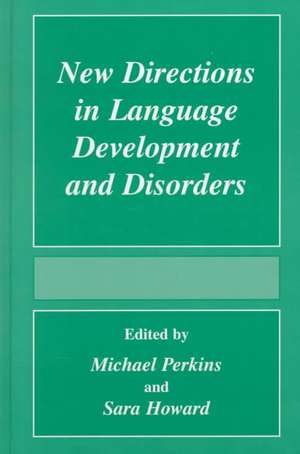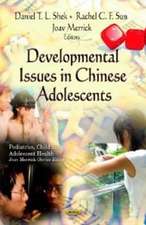New Directions In Language Development And Disorders
Editat de Michael Perkins, Sara Howarden Limba Engleză Hardback – 30 dec 1999
| Toate formatele și edițiile | Preț | Express |
|---|---|---|
| Paperback (1) | 949.42 lei 6-8 săpt. | |
| Springer Us – 16 oct 2012 | 949.42 lei 6-8 săpt. | |
| Hardback (1) | 956.81 lei 6-8 săpt. | |
| Springer Us – 30 dec 1999 | 956.81 lei 6-8 săpt. |
Preț: 956.81 lei
Preț vechi: 1166.84 lei
-18% Nou
Puncte Express: 1435
Preț estimativ în valută:
183.08€ • 192.18$ • 151.96£
183.08€ • 192.18$ • 151.96£
Carte tipărită la comandă
Livrare economică 10-24 aprilie
Preluare comenzi: 021 569.72.76
Specificații
ISBN-13: 9780306462849
ISBN-10: 0306462842
Pagini: 303
Ilustrații: XI, 303 p.
Dimensiuni: 178 x 254 x 19 mm
Greutate: 0.77 kg
Ediția:2000
Editura: Springer Us
Colecția Springer
Locul publicării:New York, NY, United States
ISBN-10: 0306462842
Pagini: 303
Ilustrații: XI, 303 p.
Dimensiuni: 178 x 254 x 19 mm
Greutate: 0.77 kg
Ediția:2000
Editura: Springer Us
Colecția Springer
Locul publicării:New York, NY, United States
Public țintă
ResearchDescriere
Research into child language development is being conducted more extensively, by more people, and in more countries throughout the world than at any point in the past. We now know more than we ever did before about the linguistic, cognitive, neurobio logical, and social capacities that children bring to their language learning task, as well as the ways in which these capacities interact with a whole range of factors present in the child's environment throughout the learning process, not least the particular character istics of the language or languages to which the child is exposed. Far from inducing a sense of complacency, this new knowledge seems instead to create an even stronger impetus to know more. This is partly because of the new and unforeseen questions it raises and partly because of competition between different theories to provide the best explanation of the phenomenon, and which in turn engender different methods of enquiry. This volume addresses many of the key issues which are currently exercising the minds of child language researchers, and which are likely to motivate research for some years to come. The chapters included here-all previously unpublished-present a great deal of new data and address a range of theoretical issues from a variety of perspectives.
Cuprins
Preface. 1. Normal and Abnormal Language Development: Common Ground? Theories of language learning and children with specific language impairment; L.B. Leonard. The relevance of recent research on SLI to our understanding of normal language development; G. Conti-Ramsden. Time parsing, normal language acquisition, and language-related developmental disorders; J. Boucher. How optional is 'optional' in the Extended Optional Infinitive stage? K. Brunger, A. Henry. Derivational morphology in SLI children: structure and semantics of Hebrew nouns; D. Ravid, et al. Speech monitoring in retarded children: evidence for metalinguistic competencies; Y. Levy, et al. Gesture use by two children with tracheostomy: getting ready to use words; M. Kertoy, A. Morrison. 2. Language Universals and Language Specifics. Three hypotheses on early grammatical development; M Garman, et al. Could a Chomskyan child learn Polish? The logical argument for language learning; E. Dabrowska. On the acquisition of pronominal reference in child-Greek; S. Varlokosta, et al. The emergence of periphrastic questions in child-French; B. Plunkett. 3. Argument Structure. The role of performance limitations in the acquisition of 'mixed' verb-argument structure at Stage I; A.L. Theakston, et al. Argument structure preferences in pre-school and school-age children; R. Ingham, et al. Argument structure alternation in French children's speech; I. Barriere, et al. 4. Verbs and Verb Morphology. Lexically-specified patterns in early verbal morphology in Spanish; V.C. Mueller Gathercole, et al. Infants of 24-30 months understand verb frames ; E.L. Bavin, C. Growcott. Morphological future in Italian children; C. Bazzanella, C. Bosco. Cross-linguistic developmental evidence of implicit causality in visual perception and cognition verbs; F. Franco, et al. What they hear is what you get? Infinitives and modality in child language and child-directed speech; E. Blom, et al. 5. Phonology. An experimental and computational exploration of developmental patterns in lexical access and representation; T. Loucas, W.D. Marslen-Wilson. Learning to produce three-syllable words: a longitudinal study of Finnish twins; T. Savinainen-Makkonen. The acquisition of the systematic use of pitch by German /English bilingual children: evidence for two separate phonological systems; U. Gut. 6. Pragmatics and Discourse. Acquisition of sentence-final particles in Japanese; J. Shirai, et al. Cohesion and coherence anomalies and their effects on children's referent introduction in narrative retell; M. Hickmann, P. Schneider. 7. Literacy. The cognitive determinants of literacy skills in a regular orthography; D. Nikoloulos, N. Goulandris. Social class does not predict reading success, but language and metalinguistic skills do; C. Chaney. Do children with literacy difficulties have non-native-like CVC perception? N. Thyer, et al. Index.







